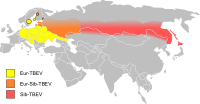
Evaluation of a semi-automated in vitro feeding system for Dermacentor reticulatus and Ixodes ricinus adults
Sign Up to like & getrecommendations! Published in 2017 at "Parasitology Research"
DOI: 10.1007/s00436-017-5648-y
Abstract: The long feeding duration of ixodid ticks and need for regular blood changes turns the artificial feeding of ticks into a tedious process. To reduce the number of blood changes, a semi-automated system (SAS) for… read more here.
Keywords: system; reticulatus; dermacentor reticulatus; vitro feeding ... See more keywords

Dermacentor reticulatus in Berlin/Brandenburg (Germany): Activity patterns and associated pathogens.
Sign Up to like & getrecommendations! Published in 2019 at "Ticks and tick-borne diseases"
DOI: 10.1016/j.ttbdis.2018.10.003
Abstract: Dermacentor reticulatus is one of the most important European tick species. However, its spatial distribution, seasonality and regional vector role are not well known. This study aimed to gather information about abundance patterns of questing… read more here.
Keywords: reticulatus; associated pathogens; berlin brandenburg; dermacentor reticulatus ... See more keywords

Origins of recently emerged foci of the tick Dermacentor reticulatus in central Europe inferred from molecular markers.
Sign Up to like & getrecommendations! Published in 2017 at "Veterinary parasitology"
DOI: 10.1016/j.vetpar.2017.02.020
Abstract: The ornate dog tick Dermacentor reticulatus is vector of several blood parasites, including Babesia canis, a causative agent of babesiosis. The geographical range of D. reticulatus in Europe is discontinuous with a gap separating eastern… read more here.
Keywords: poland; tick dermacentor; central europe; dermacentor reticulatus ... See more keywords

Abundance of the tick Dermacentor reticulatus in an ecosystem of abandoned meadows: Experimental intervention and the critical importance of mowing.
Sign Up to like & getrecommendations! Published in 2017 at "Veterinary parasitology"
DOI: 10.1016/j.vetpar.2017.09.004
Abstract: The effect of agricultural activities on the environment has been falling in many areas of Europe in recent years and the associated abandonment of crop fields, meadows and pastures may enable an increase in tick… read more here.
Keywords: fallow land; mowing; reticulatus; abundance ... See more keywords

Francisella tularensis prevalence and load in Dermacentor reticulatus ticks in an endemic area in Central Europe
Sign Up to like & getrecommendations! Published in 2017 at "Medical and Veterinary Entomology"
DOI: 10.1111/mve.12229
Abstract: A total of 7778 host‐seeking adult Dermacentor reticulatus (Ixodida: Ixodidae) ticks were examined for the prevalence of Francisella tularensis holarctica (Thiotrichales: Francisellaceae) in a natural focus of tularaemia in the floodplain forest–meadow ecosystem along the… read more here.
Keywords: tularensis; prevalence; reticulatus; dermacentor reticulatus ... See more keywords

Distribution of the tick Dermacentor reticulatus in the United Kingdom
Sign Up to like & getrecommendations! Published in 2017 at "Medical and Veterinary Entomology"
DOI: 10.1111/mve.12235
Abstract: The recent implication of Dermacentor reticulatus (Ixodida: Ixodidae) in the transmission of canine babesiosis in the U.K. has highlighted the lack of accurate published data on its distribution in this country. This paper aims to… read more here.
Keywords: distribution; dermacentor reticulatus; distribution tick; reticulatus ... See more keywords

Climate and the seasonal abundance of the tick Dermacentor reticulatus
Sign Up to like & getrecommendations! Published in 2021 at "Medical and Veterinary Entomology"
DOI: 10.1111/mve.12518
Abstract: Dermacentor reticulatus (Ixodida: Ixodidae, Fabricius 1794) is one of the most widely distributed and abundant tick species in central Europe and is a vector for a range of pathogens. Nevertheless, many aspects of its ecology… read more here.
Keywords: seasonal abundance; tick; reticulatus; dermacentor reticulatus ... See more keywords

Gynandromorphism and local morphological abnormalities in Dermacentor reticulatus (Acari: Ixodidae)
Sign Up to like & getrecommendations! Published in 2017 at "Systematic and Applied Acarology"
DOI: 10.11158/saa.22.4.1
Abstract: Abstract Morphological abnormalities in ticks seem to be very rare phenomena. In this paper, we describe interesting anomalies in adult Dermacentor reticulatus collected as questing ticks by flagging as part of a tick-borne encephalitis program… read more here.
Keywords: morphological abnormalities; reticulatus; local morphological; gynandromorphism local ... See more keywords

Tick-borne pathogens in ticks collected from dogs, Latvia, 2011–2016
Sign Up to like & getrecommendations! Published in 2019 at "BMC Veterinary Research"
DOI: 10.1186/s12917-019-2149-5
Abstract: BackgroundDifferent tick species are able to transmit different pathogens, and tick-borne diseases are of substantial concern worldwide for both humans and animals. Environmental changes and changes in the range of tick species, including Dermacentor reticulatus… read more here.
Keywords: 2011 2016; borne pathogens; tick borne; dermacentor reticulatus ... See more keywords

Identification of Dermacentor reticulatus Ticks Carrying Rickettsia raoultii on Migrating Jackal, Denmark
Sign Up to like & getrecommendations! Published in 2017 at "Emerging Infectious Diseases"
DOI: 10.3201/eid2312.170919
Abstract: From a migrating golden jackal (Canis aureus), we retrieved 21 live male Dermacentor reticulatus ticks, a species not previously reported from wildlife in Denmark. We identified Rickettsia raoultii from 18 (86%) of the ticks. This… read more here.
Keywords: dermacentor reticulatus; reticulatus ticks; rickettsia raoultii; jackal ... See more keywords

High Prevalence and Low Diversity of Rickettsia in Dermacentor reticulatus Ticks, Central Europe
Sign Up to like & getrecommendations! Published in 2022 at "Emerging Infectious Diseases"
DOI: 10.3201/eid2804.211267
Abstract: We collected 1,671 Dermacentor reticulatus ticks from 17 locations in the Czech Republic, Slovakia, and Hungary. We found 47.9% overall prevalence of Rickettsia species in ticks over all locations. Sequence analysis confirmed that all tested… read more here.
Keywords: prevalence; reticulatus ticks; rickettsia; dermacentor reticulatus ... See more keywords